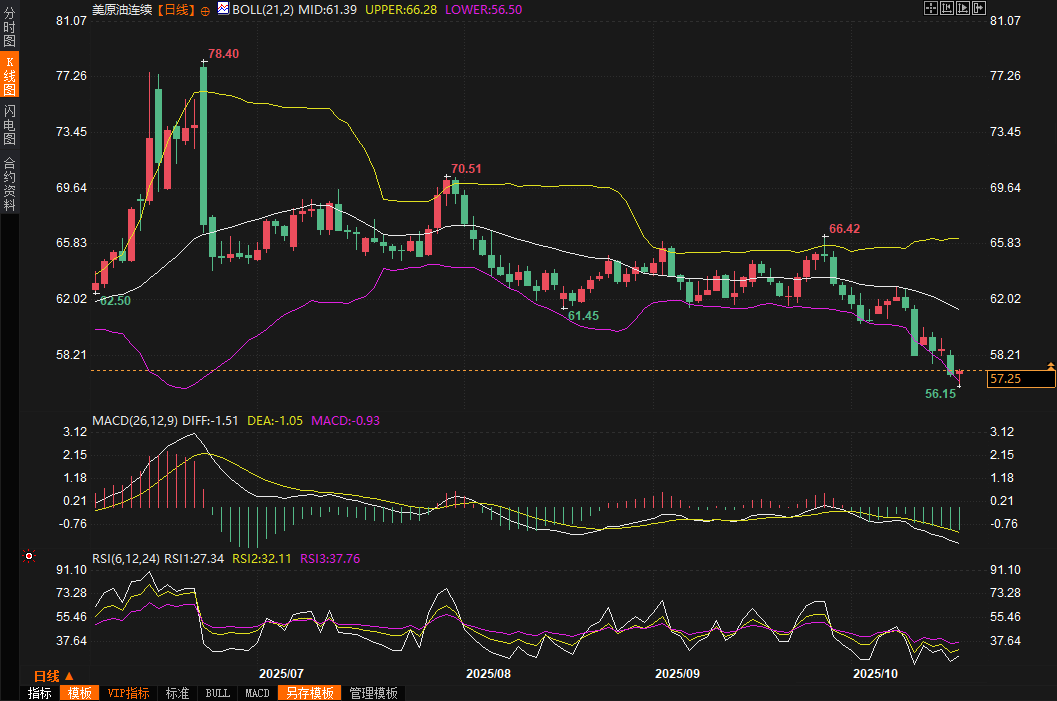Oil prices fell for the third consecutive week to a five-month low as trade concerns reignited and Middle East peace efforts failed to mask the specter of oversupply.
2025-10-18 10:04:15

Oil prices rebounded short-lived as Sino-US trade friction escalated
Oil prices experienced a respite at the start of the week. Brent and U.S. crude futures rose about 1% on Monday, closing at $63.32 and $59.49, respectively. This was helped by news of a potential meeting between Chinese and American leaders during the APEC summit in South Korea, easing tensions that had escalated last week following China's expanded rare earth export controls and the U.S. threat of a 100% tariff.
U.S. Treasury Secretary Jeffrey Bessant publicly stated that the two sides had extensive communications over the weekend and stressed that the situation had eased significantly. Analysts pointed out that this willingness to negotiate has temporarily curbed the market's selling sentiment, especially against the backdrop of a sharp drop in oil prices during the peak of the trade war in March and April this year.
However, this optimism was short-lived. With the trade war reignited, oil prices began a sharp decline on Tuesday. On Thursday and Friday, oil prices hit five-month lows for two consecutive days. On Friday, Brent crude plummeted to $60.33, and WTI crude fell to $56.15, both lows since early May. The US's imposition of additional port fees on Chinese cargo vessels further disrupted global oil transportation chains and exacerbated market concerns about declining demand.
IEA oversupply alarm sounds, casting a shadow on demand outlook
The International Energy Agency (IEA)'s monthly report was another major driver of this week's decline in oil prices. On Tuesday, the IEA raised its forecast for global oil supply growth this year while lowering its demand growth forecast, warning that the market could face a massive surplus of up to 4 million barrels per day by 2026. This stands in stark contrast to the relatively optimistic view of the Organization of the Petroleum Exporting Countries (OPEC), which believes that increased production from the OPEC+ alliance will narrow the supply gap.
While oil majors anticipate a tightening market in the medium and long term, short-term signs of weakness are deterring investors. Adding to the woes, data released Thursday by the U.S. Energy Information Administration (EIA) showed that U.S. crude oil inventories rose by 3.5 million barrels to 423.8 million barrels last week, far exceeding analysts' expectations of a 288,000-barrel increase. This was primarily due to reduced refinery utilization as refineries entered their autumn maintenance period.
Meanwhile, U.S. crude oil production surged to a record high of 13.636 million barrels per day, further exacerbating concerns about oversupply. Chinese customs data showed that while crude oil imports in September increased 3.9% year-on-year to 11.5 million barrels per day, they fell 4.5% month-on-month, indicating weak demand. Deflationary pressures in major Asian countries and Federal Reserve Board Governor Milan's warnings about the downside risks to the economy from trade tensions have also made it difficult for loose monetary policy to boost oil demand.
Signs of geopolitical easing emerged, but failed to reverse the downward trend
There were some glimmers of hope in the geopolitical arena this week, but they failed to boost oil prices. Last Sunday (October 13th), Trump declared the Gaza War over, and on Monday (October 14th), Hamas released the final 20 hostages under US-brokered measures, limiting the expansion of the Middle East risk premium. On Thursday, Trump spoke with Russian President Vladimir Putin for over two hours and agreed to hold a summit in Budapest to discuss Ukraine, a plan confirmed by the Kremlin. On Friday, Ukrainian President Volodymyr Zelensky visited the US to push for greater military support, while the US pressured India and China to halt purchases of Russian oil, potentially reshaping global oil flows.
Trump's announcement that India would halt Russian oil imports further heightened energy supply uncertainty. While these developments have eased some concerns about global conflict, analysts believe that renewed tensions between Russia, the United States, and Ukraine have prompted some traders to exit their positions. While oil prices rebounded slightly on Friday, with prices rebounding by 0.38% and 0.14%, they still ended the week down nearly 3%, demonstrating that geopolitical easing has failed to offset trade and supply pressures.
Summarize
In summary, the drop in oil prices this week highlights the fragility of the international energy market. The resurgence of the international trade war and the IEA's oversupply warning have dominated the downward trend. Although the partial easing of geopolitics provides a buffer, it cannot conceal the reality of weak global demand.
Looking ahead to next week, investors will closely monitor a potential meeting between Trump and Chinese President Xi Jinping, as well as OPEC+'s production increases. If trade negotiations achieve a breakthrough, oil prices could rebound. Conversely, if tensions escalate, Bank of America warns that Brent crude could fall below $50. Amidst this uncertainty, the crude oil market is expected to remain highly volatile, and investors are advised to exercise caution.

(US crude oil daily chart, source: Yihuitong)
- Risk Warning and Disclaimer
- The market involves risk, and trading may not be suitable for all investors. This article is for reference only and does not constitute personal investment advice, nor does it take into account certain users’ specific investment objectives, financial situation, or other needs. Any investment decisions made based on this information are at your own risk.





















